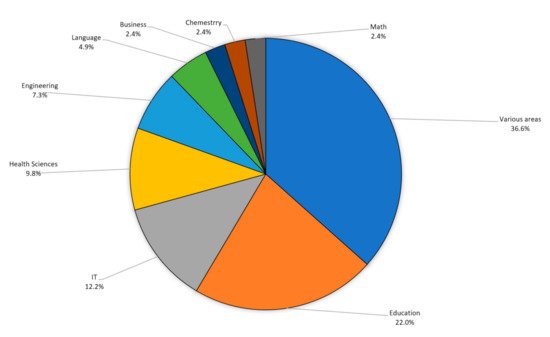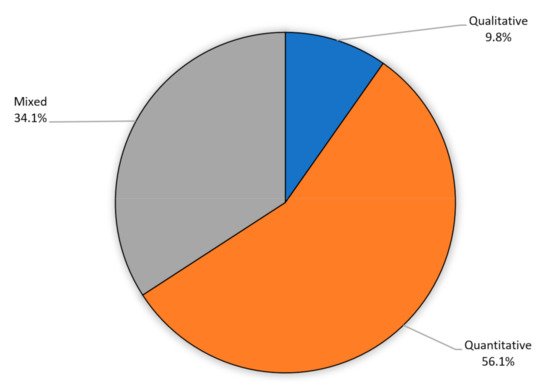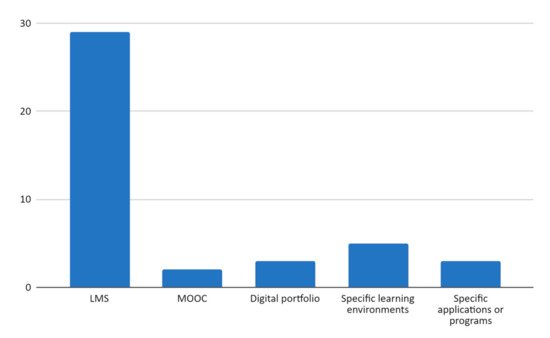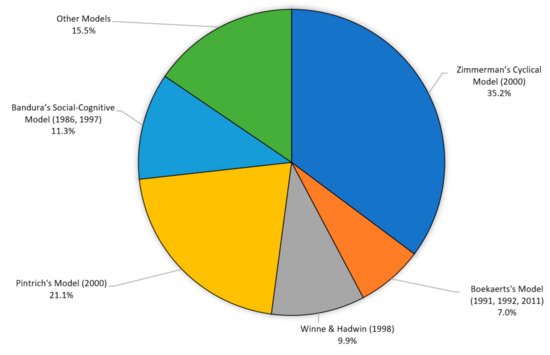You're using an outdated browser. Please upgrade to a modern browser for the best experience.
Please note this is a comparison between Version 1 by Santos Urbina and Version 3 by Bruce Ren.
This papentryr seeks to identify the characteristics of studies of self-regulated learning that consider the use of technology-enriched environments in higher education. To this end, a review was conducted of the scientific literature during the period 2015–2021 in various scientific databases.
- self-regulated learning
- ICT
- technology-enhanced learning environments
- scoping review
Note: The following contents are extract from your paper. The entry will be online only after author check and submit it.
1. Introduction
The concept that students are active agents that have become the centre of the teaching–learning process is a powerful idea in research related to educational technology. In technology-enriched learning environments, one of the keys to achieving learning goals lies in the autonomous management of a skill set that contributes to such an achievement. This is a set of transferable skills that are usually related to the concept of self-regulated learning (SRL). The concern lies in the student controlling his/her own learning process, a topic that began to be researched in the mid-1980s [1].
Carneiro et al. [2] differentiated between two forms of the concept of self-regulated learning: one, which is more restrictive, refers to the self-regulation of learning processes by the student himself/herself to carry out a given task (where more didactic strategies would come into play in formal educational contexts), oriented, therefore, at autonomy in the process; and another, broader one is equivalent to self-directed learning and refers to taking the initiative and responsibility in selecting, managing and assessing their own learning activities, which may occur at any time, place, age and through any means (which may include informal learning processes), oriented more at learning to learn [3][4][5][3,4,5].
The purpose of this study was to seek models that will contribute to representing aspects of self-regulated learning in technology-enhanced learning environments, especially in the second sense. Classical works on self-regulated learning by Zimmermann and others [6][7][8][9][10][11][12][13][6,7,8,9,10,11,12,13] have given rise to various models for representing self-regulated learning but only where technology was not yet a consideration. Among them, those by Zimmerman [14] and Pintrich [9] may be considered leading studies and have strongly influenced later ones. Both models are based on socio-cognitive postulates, and both of them explain self-regulated learning as a cyclical process, influenced by context, where the process is organized into phases in which cognitive, meta-cognitive and motivational strategies are selected and combined but always in conventional environments.
The interest in studying aspects of autonomous learning that began in the 1980s crystallised into a research trend focused on self-regulation and from which several various models inspired by various theoretical approaches arose [15]. Papers on self-regulated learning based on Bandura’s socio-cognitive theory have had the greatest impact, and of all of them, those by Zimmerman [14] and Pintrich [9] are the most widely used, especially regarding early educational stages.
These models share certain characteristics: self-sufficiency is an essential variable for both models; the presence of a feedback or review model in which the students control the learning methods and strategies or the reasons why students choose a certain strategy during the self-regulation process are others [15][16][15,16]. However, they also show certain differences: while Zimmerman’s model [14] shows greater explanatory power and has been the predominant model in research in the field of education when working with teachers, the model proposed by Pintrich [9] includes the link between the cognitive and affective-motivational factors that come into play during the learning process or highlight the influence of the social context in which it takes place.
The conceptual complexity the self-regulated learning construct offers has stimulated recent research into self-regulation of learning and about the models developed to explain it in the information and knowledge society. One of the most comprehensive studies was by Panadero [15]; it analysed and compared six models according to their implications for education: Zimmerman; Boekaerts; Winne and Hadwin; Pintrich; Efklides; and that by Hadwin, Järvelä and Miller.
However, it would be desirable to be able to determine to what extent technology-enriched environments can foster the development of self-regulated learning. We therefore believe it is of interest to offer an overview of recent research around this topic by analysing the scientific literature in the form of a scoping review.
In the current university context, competency-based assessment aims to enable students to be competent in the use of technological tools in their future professional performance in a sustainable manner.
These skills, in the world of work, are essential for coping with lifelong learning. Based on this idea, it is necessary that students learn to self-regulate in educational processes, acquiring sustainable and long-lasting habits.
2. Selection, Extraction and Presentation in Graphic Form of the Evidence
This section answers the different research questions and analyses additional aspects of interest.
2.1. Years of Publication of the Evidence Selected
Below are 41 papers from the selected sample (Table 1), in table form and ordered chronologically. The search was made in December 2020 (although some publications from 2021 were already accessible, one of which was included in the end).
Table 1. Identification of studies by year of publication.
| Year of Publication | Reference | n | |||||||||||||||||||
|---|---|---|---|---|---|---|---|---|---|---|---|---|---|---|---|---|---|---|---|---|---|
| 2015 | [17][18] | [22,23] | QR codes Portfolio( | n | = 2) | ||||||||||||||||
| -Questionnaires | Scales Interviews with the students Interview with the teaching staff Document analysis -Portfolios |
2016 | [19][20][21][22][23][24][25][26] | [24,25,26,27,28,29,30,31] | ( | n | = 8) | ||||||||||||||
| Bandura’s social-cognitive model (1986, 1997) | Virtual learning environments (LMS) Tutorials PLE Virtual reality |
Scales Questionnaires Portfolios |
2017 | [27][28][29][30][31][32 | |||||||||||||||||
| Boekaerts’s Heuristic Model (1995, 1996) | ] | [32,33,34,35,36,37] | Virtual learning environments (LMS)( | n | = 6) | ||||||||||||||||
| Questionnaires | 2018 | [33][34][35][36][][41] | [38,39,40 | 37][38][39 | ,41 | ] | ,42 | [ | ,43,44 | 40 | ,45,46] | ( | n | = 9) | |||||||
| 2019 | [42][43][44]51] | [47,48 | [ | ,49 | 45] | ,50 | [46] | ,51 | [47] | ,52 | [48] | ,53 | [49] | ,54 | [50] | ,55 | [ | ,56] | ( | n | = 10) |
| 2020 | [52][53][54][55][56] | [57,58,59,60,61] | ( | n | = 5) | ||||||||||||||||
| 2021 | [57] | [62] | ( | n | = 1) |
As can be observed, the highest number of publications was in 2019 (n = 10), followed by 2018 (n = 9) and 2017 (n = 8). On the other hand, a slight fall in the number of publications was witnessed in 2020 (n = 5).
2.2. Context of the Studies
As regards contextualisation, specifically the university studies where the research analysed was carried out, a cross-cutting approach prevails; most of it was carried out in various faculties (n = 15). However, we found 22% of studies carried out in faculties of Education (n = 9). This was followed by studies related to Computer Science (n = 5) and Health Sciences (n = 4) (see Figure 1).


Figure 1. Areas of knowledge.
2.3. Research Methodology
As regards the methodological perspective adopted in the various studies, the quantitative approach is the most prevalent (n = 23). Mixed studies amounted to slightly less than a third (n = 14), and only four were carried out using a qualitative methodological option. Figure 2 shows their distribution in graphic form.


Figure 2. Research methodology.
The vast majority of the studies analysed use the questionnaire as the data collection tool. This tool is used by both quantitative and qualitative studies, in this case, using open-ended questions, where the topics of study may be expressed without restrictions. Specifically, of the 41 papers analysed, a total of 22 used a questionnaire to collect information. We may also observe that quite a few of the studies (n = 10) used the standardised MSLQ questionnaire or a variant to be able to verify the students’ level of self-regulation. As regards qualitative studies, they adopted varied data collection techniques, such as self-reporting, interviews, document analysis or a focus group.
2.4. Technological Elements or Environments Used
The technological resources analysed in the research papers were grouped into five broad categories: LMS (n = 29) (either standard ones or made by the institutions themselves); learning environments designed with specific characteristics as tutoring systems, adaptive, created to cover the specific needs of patients (in university degrees in health) or a virtual reality environment (n = 5); application, specific web 2.0 programs (n = 3); e-portfolio (n = 2); MOOC (n = 2) (Figure 3).


Figure 3. Technological resources and strategies used to promote self-regulation.
2.5. Self-Regulation Models
The research initiated by Zimmerman [11] was the forerunner in this field. The concept of self-regulation is understood as a process consisting of self-generated thoughts, emotions and actions planned cyclically to achieve personal goals [14]. The analysis shows its theoretical influence on the development of the papers, along with other models that have arisen from it (Figure 4). However, the documents mention more than one conceptualisation to support the development of the research.


Figure 4. Self-regulation models.
Firstly, it is necessary to say that the starting framework, in most papers, is not limited to a single author or conceptualisation. The theoretical perspective most often mentioned in the papers is the cyclical model proposed by Zimmerman [14] and its later revision [58][63] (n = 25). According to this concept, self-regulation is organised around three phases: anticipation, execution and self-reflection. Below is the model created by Pintrich [9] (n = 15) based on four phases aimed at self-regulation of learning: anticipation, monitoring, control and reflection. Both models represent the highest share of the papers analysed. However, there are others, such as Bandura’s social-cognitive model [59][64] (n = 8), the model proposed by Winne and Hadwin [60][65] (n = 7) and Boekaerts’s heuristic model [6][61][6,66] (n = 5).
Normally, these models offer the basis required by way of theoretical support for the studies considered. Each of them implies a series of inherent presuppositions, though these elements are not always made explicit.
The following table (Table 2) relates, in summary form, the factors that are clearly expressed in the research: technology and SRL level assessment strategies. It should be noted that the table does not seek to establish any kind of relationship but rather simply to illustrate the findings in an orderly manner in the papers analysed in descriptive form.
Table 2. Self-regulation, technology and assessment models.
| Reference Models | Technological Resources to Promote Self-Regulation | SRL Assessment Strategies | ||
|---|---|---|---|---|
| Zimmerman’s cyclical model (2000) | Infographics Virtual learning environments (LMS) MOOC | |||
| Winne and Hadwin (1998) | ||||
| Virtual learning environments (LMS) | Intelligent tutoring system |
Questionnaires Scales |
||
| Pintrich Model | (2000) | Virtual learning environments (LMS) MOOC |
Questionnaires Scales |
The LMSs adopted by the institution are usually the most-studied technological factor aimed at making it easier for students to achieve their aims and to achieve self-regulation. That may be due, firstly, to their extensive presence in universities; also, and as a result thereof, the teaching staff and students’ familiarity with and knowledge of the environments and their tools would be determining factors. At all events, a large share of the studies reviewed, albeit they discuss some technological resources, do not analyse in detail the involvement of these elements in the various aspects of self-regulation nor in how they are used or may affect regulation of learning.
